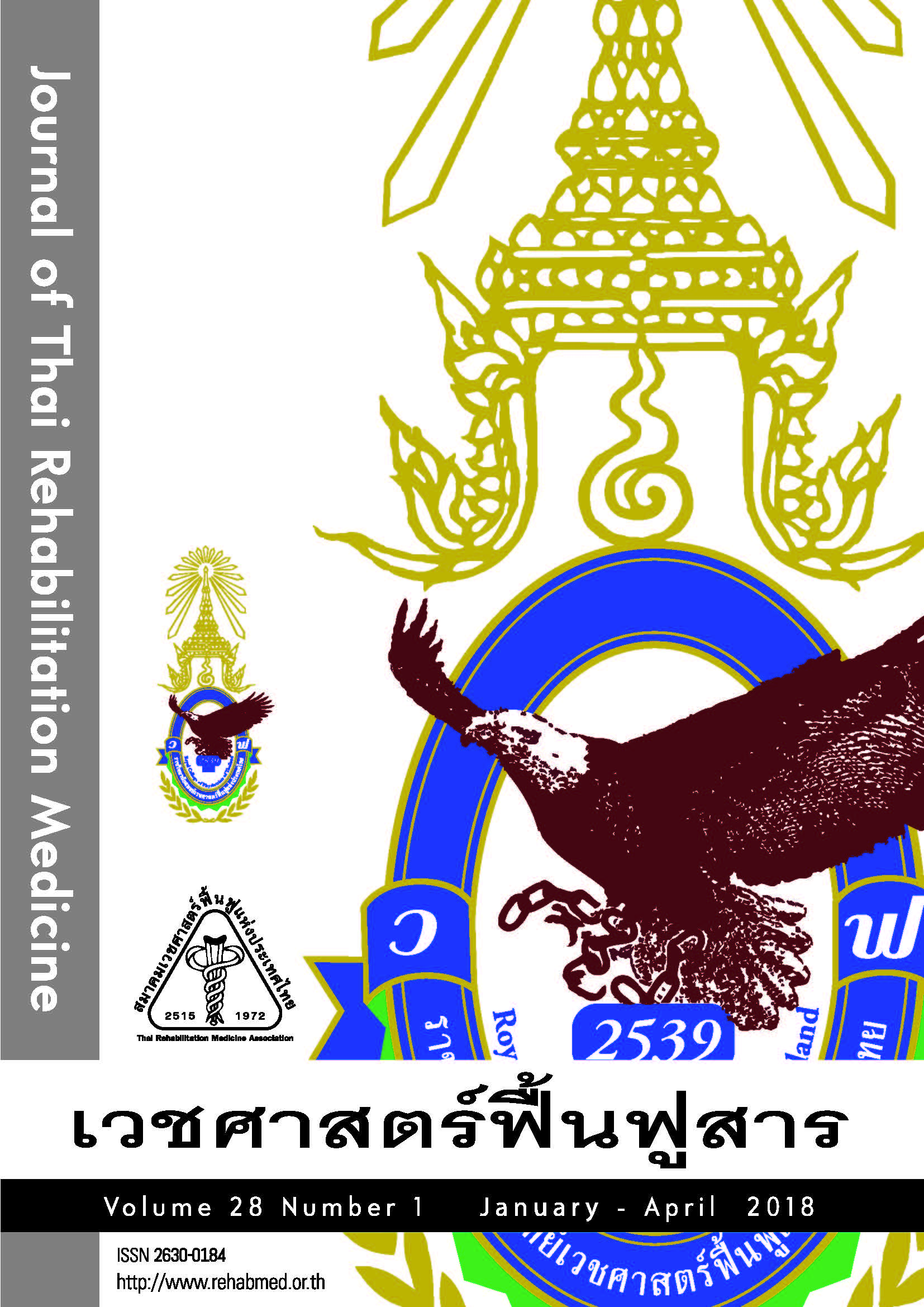ค่าความน่าเชื่อถือของการวัดค่าตัวแปรการเดินในเด็กปกติอายุ 7 ถึง 11 ปี ด้วยเครื่องวิเคราะห์การเดิน TailGait
ค่าความน่าเชื่อถือของการวัดค่าตัวแปรการเดินในเด็กปกติอายุ 7 ถึง 11 ปี ด้วยเครื่องวิเคราะห์การเดิน TailGait
Keywords:
TailGait, Gait analysis, normal children, reliabilityAbstract
Objective: To study the test-retest reliability of temporal-spatial gait parameters’ measurement in normal children betweeen 7 to 11 years using the TailGait gait analysis system.
Study design: An observational correlation study.
Setting: A public primary school at Samrong, Samutprakarn, Thailand
Method: A convenient sample of 30 students from primary class 2nd,3rd, and 4th was selected and the students were invited to participate in the study. Each of the students put on the force sensing shoes, data logging belts and the distance measurement “tail” and then they successively walked two laps across the semi-outdoor basketball court at self-selected and comfortable speed. Correlation coefficient of the first and temporal-spatial gait parameters from the two trials were then calculated.
Results: The correlation coefficients of walking speed, cadence, and stride time between the two measurements were 0.83, 0.89, 0.88 respectively. The correlation coefficients of left stance time, right stance time, left swing time and right swing time between the two measurements were 0.84, 0.88, 0.83 and 0.84 respectively. Also, the correlation coefficients of stride length, left step length and right step length between the two measurements were 0.77, 0.89, and 0.72 respectively. Our results also showed that the correlation between each one of the above-mentioned gait parameters form and the two measurements was statistically significant at p <0.001.
Conclusion: The retest reliability of TailGait measurements of speed, cadence, stride time, and bilateral stance and swing time in normal children, 7-11 years old, was high but the retest reliability of stride length, left step length and right step length was moderate to high.
References
2. Van Uden CJ, Besser MP. Test-retest reliablility of temporal and spatial gait characteristic measured with an instrumented walkway system (GAITRite®) BMC
Musculoskelet Disord. 2004;5:13.
3. Thorpe DE, Duising SC, Moore CG. Repeatability of Temporospatial Gait Measures in Children Using the GAITRite® Electronic Walkway. Arch Phys Med Rehabil. 2005;86:2342–6.
4. Khiewcham P, Vongpipatana S, Wongphaet P, Thipsook K. Effect of Vojta Therapy on Gait of Children with Cerebral Palsy. Journal of Thai Rehabilitation Medicine 2016;26:91–7.
5. Arya KN, Pandian S. Interlimb neural coupling: implications for poststroke hemiparesis. Ann Phys Rehabil Med. 2014;57:696-713.
6. Huang HJ, Ferris DP. Computer simulations of neural mechanisms explaining upper and lower limb excitatory neural coupling. J Neuroeng Rehabil. 2010;7:59. doi:10.1186/1743-0003-7-59.
7. Stolze H, Kuhtz-Buschbeck JP, Mondwurf C, Joehnk K, Friege L. Retest reliability of spatiotemporal gait parameters in children and adults. Gait Posture.1998;7:125-30.
8. Hausdorff JM, Rios DA, Edelberg HK. Gait variability and fall risk in community-living older adults: a 1-year prospective study. Arch Phys Med Rehabil. 2001;82:1050-6.




